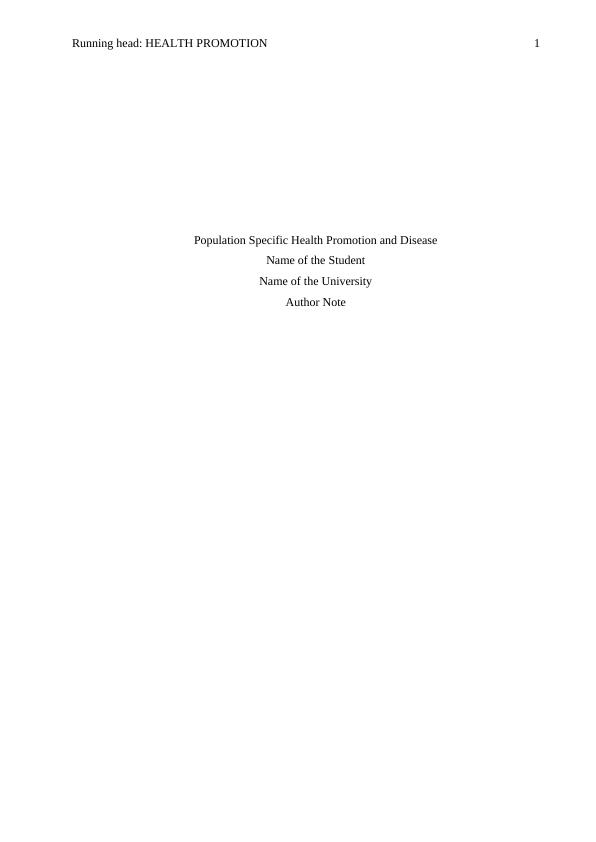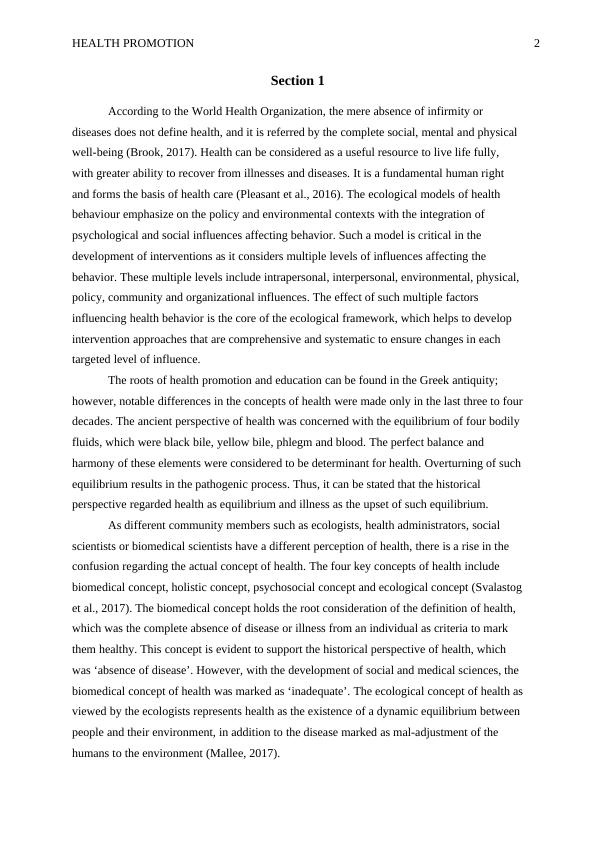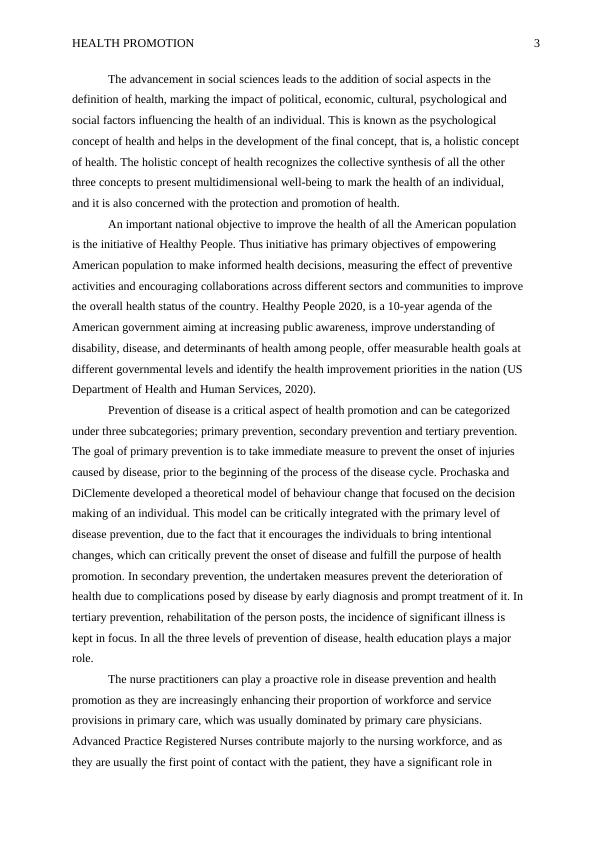Health Promotion Management Analysis
The assignment is to write a final paper on population specific health promotion and disease prevention, focusing on the vulnerable population of homeless individuals, specifically adolescents to early twenties.
11 Pages4344 Words30 Views
Added on 2022-08-24
Health Promotion Management Analysis
The assignment is to write a final paper on population specific health promotion and disease prevention, focusing on the vulnerable population of homeless individuals, specifically adolescents to early twenties.
Added on 2022-08-24
ShareRelated Documents
Running head: HEALTH PROMOTION 1
Population Specific Health Promotion and Disease
Name of the Student
Name of the University
Author Note
Population Specific Health Promotion and Disease
Name of the Student
Name of the University
Author Note

HEALTH PROMOTION 2
Section 1
According to the World Health Organization, the mere absence of infirmity or
diseases does not define health, and it is referred by the complete social, mental and physical
well-being (Brook, 2017). Health can be considered as a useful resource to live life fully,
with greater ability to recover from illnesses and diseases. It is a fundamental human right
and forms the basis of health care (Pleasant et al., 2016). The ecological models of health
behaviour emphasize on the policy and environmental contexts with the integration of
psychological and social influences affecting behavior. Such a model is critical in the
development of interventions as it considers multiple levels of influences affecting the
behavior. These multiple levels include intrapersonal, interpersonal, environmental, physical,
policy, community and organizational influences. The effect of such multiple factors
influencing health behavior is the core of the ecological framework, which helps to develop
intervention approaches that are comprehensive and systematic to ensure changes in each
targeted level of influence.
The roots of health promotion and education can be found in the Greek antiquity;
however, notable differences in the concepts of health were made only in the last three to four
decades. The ancient perspective of health was concerned with the equilibrium of four bodily
fluids, which were black bile, yellow bile, phlegm and blood. The perfect balance and
harmony of these elements were considered to be determinant for health. Overturning of such
equilibrium results in the pathogenic process. Thus, it can be stated that the historical
perspective regarded health as equilibrium and illness as the upset of such equilibrium.
As different community members such as ecologists, health administrators, social
scientists or biomedical scientists have a different perception of health, there is a rise in the
confusion regarding the actual concept of health. The four key concepts of health include
biomedical concept, holistic concept, psychosocial concept and ecological concept (Svalastog
et al., 2017). The biomedical concept holds the root consideration of the definition of health,
which was the complete absence of disease or illness from an individual as criteria to mark
them healthy. This concept is evident to support the historical perspective of health, which
was ‘absence of disease’. However, with the development of social and medical sciences, the
biomedical concept of health was marked as ‘inadequate’. The ecological concept of health as
viewed by the ecologists represents health as the existence of a dynamic equilibrium between
people and their environment, in addition to the disease marked as mal-adjustment of the
humans to the environment (Mallee, 2017).
Section 1
According to the World Health Organization, the mere absence of infirmity or
diseases does not define health, and it is referred by the complete social, mental and physical
well-being (Brook, 2017). Health can be considered as a useful resource to live life fully,
with greater ability to recover from illnesses and diseases. It is a fundamental human right
and forms the basis of health care (Pleasant et al., 2016). The ecological models of health
behaviour emphasize on the policy and environmental contexts with the integration of
psychological and social influences affecting behavior. Such a model is critical in the
development of interventions as it considers multiple levels of influences affecting the
behavior. These multiple levels include intrapersonal, interpersonal, environmental, physical,
policy, community and organizational influences. The effect of such multiple factors
influencing health behavior is the core of the ecological framework, which helps to develop
intervention approaches that are comprehensive and systematic to ensure changes in each
targeted level of influence.
The roots of health promotion and education can be found in the Greek antiquity;
however, notable differences in the concepts of health were made only in the last three to four
decades. The ancient perspective of health was concerned with the equilibrium of four bodily
fluids, which were black bile, yellow bile, phlegm and blood. The perfect balance and
harmony of these elements were considered to be determinant for health. Overturning of such
equilibrium results in the pathogenic process. Thus, it can be stated that the historical
perspective regarded health as equilibrium and illness as the upset of such equilibrium.
As different community members such as ecologists, health administrators, social
scientists or biomedical scientists have a different perception of health, there is a rise in the
confusion regarding the actual concept of health. The four key concepts of health include
biomedical concept, holistic concept, psychosocial concept and ecological concept (Svalastog
et al., 2017). The biomedical concept holds the root consideration of the definition of health,
which was the complete absence of disease or illness from an individual as criteria to mark
them healthy. This concept is evident to support the historical perspective of health, which
was ‘absence of disease’. However, with the development of social and medical sciences, the
biomedical concept of health was marked as ‘inadequate’. The ecological concept of health as
viewed by the ecologists represents health as the existence of a dynamic equilibrium between
people and their environment, in addition to the disease marked as mal-adjustment of the
humans to the environment (Mallee, 2017).

HEALTH PROMOTION 3
The advancement in social sciences leads to the addition of social aspects in the
definition of health, marking the impact of political, economic, cultural, psychological and
social factors influencing the health of an individual. This is known as the psychological
concept of health and helps in the development of the final concept, that is, a holistic concept
of health. The holistic concept of health recognizes the collective synthesis of all the other
three concepts to present multidimensional well-being to mark the health of an individual,
and it is also concerned with the protection and promotion of health.
An important national objective to improve the health of all the American population
is the initiative of Healthy People. Thus initiative has primary objectives of empowering
American population to make informed health decisions, measuring the effect of preventive
activities and encouraging collaborations across different sectors and communities to improve
the overall health status of the country. Healthy People 2020, is a 10-year agenda of the
American government aiming at increasing public awareness, improve understanding of
disability, disease, and determinants of health among people, offer measurable health goals at
different governmental levels and identify the health improvement priorities in the nation (US
Department of Health and Human Services, 2020).
Prevention of disease is a critical aspect of health promotion and can be categorized
under three subcategories; primary prevention, secondary prevention and tertiary prevention.
The goal of primary prevention is to take immediate measure to prevent the onset of injuries
caused by disease, prior to the beginning of the process of the disease cycle. Prochaska and
DiClemente developed a theoretical model of behaviour change that focused on the decision
making of an individual. This model can be critically integrated with the primary level of
disease prevention, due to the fact that it encourages the individuals to bring intentional
changes, which can critically prevent the onset of disease and fulfill the purpose of health
promotion. In secondary prevention, the undertaken measures prevent the deterioration of
health due to complications posed by disease by early diagnosis and prompt treatment of it. In
tertiary prevention, rehabilitation of the person posts, the incidence of significant illness is
kept in focus. In all the three levels of prevention of disease, health education plays a major
role.
The nurse practitioners can play a proactive role in disease prevention and health
promotion as they are increasingly enhancing their proportion of workforce and service
provisions in primary care, which was usually dominated by primary care physicians.
Advanced Practice Registered Nurses contribute majorly to the nursing workforce, and as
they are usually the first point of contact with the patient, they have a significant role in
The advancement in social sciences leads to the addition of social aspects in the
definition of health, marking the impact of political, economic, cultural, psychological and
social factors influencing the health of an individual. This is known as the psychological
concept of health and helps in the development of the final concept, that is, a holistic concept
of health. The holistic concept of health recognizes the collective synthesis of all the other
three concepts to present multidimensional well-being to mark the health of an individual,
and it is also concerned with the protection and promotion of health.
An important national objective to improve the health of all the American population
is the initiative of Healthy People. Thus initiative has primary objectives of empowering
American population to make informed health decisions, measuring the effect of preventive
activities and encouraging collaborations across different sectors and communities to improve
the overall health status of the country. Healthy People 2020, is a 10-year agenda of the
American government aiming at increasing public awareness, improve understanding of
disability, disease, and determinants of health among people, offer measurable health goals at
different governmental levels and identify the health improvement priorities in the nation (US
Department of Health and Human Services, 2020).
Prevention of disease is a critical aspect of health promotion and can be categorized
under three subcategories; primary prevention, secondary prevention and tertiary prevention.
The goal of primary prevention is to take immediate measure to prevent the onset of injuries
caused by disease, prior to the beginning of the process of the disease cycle. Prochaska and
DiClemente developed a theoretical model of behaviour change that focused on the decision
making of an individual. This model can be critically integrated with the primary level of
disease prevention, due to the fact that it encourages the individuals to bring intentional
changes, which can critically prevent the onset of disease and fulfill the purpose of health
promotion. In secondary prevention, the undertaken measures prevent the deterioration of
health due to complications posed by disease by early diagnosis and prompt treatment of it. In
tertiary prevention, rehabilitation of the person posts, the incidence of significant illness is
kept in focus. In all the three levels of prevention of disease, health education plays a major
role.
The nurse practitioners can play a proactive role in disease prevention and health
promotion as they are increasingly enhancing their proportion of workforce and service
provisions in primary care, which was usually dominated by primary care physicians.
Advanced Practice Registered Nurses contribute majorly to the nursing workforce, and as
they are usually the first point of contact with the patient, they have a significant role in

HEALTH PROMOTION 4
educating them to prevent disease and promote health in them. For service delivery in
preventive care, history has majorly relied on primary care physicians. However, over 90 per
cent of the nursing practitioners are prepared for the provision of primary care and are able to
manage around 80 per cent of the care that is provided by the physicians. Advanced
Registered Nurse Practitioners can play a crucial role in educating and empowering
individuals to ensure lifestyle changes and make better health choices to increase the
prevention efficiency of chronic diseases. It is evident that individual clinical environments,
worksite health centers and college campuses provide an adequate environment for the
nursing practitioners to perform their health promotion and disease prevention activities.
Section 2
The greatest focus on disease prevention and health promotion should be concerned
with the welfare of vulnerable populations. Vulnerability as a concept can be defined as the
adverse reaction of a system to the occurrence of a hazardous event. The system’s ability to
handle the event is highly affected by the risk factors associated with vulnerability, including
economic, social and physical aspects. The concept of vulnerability, determined by the health
of a population, can be defined as diminished capacity of a group of individuals to access
health care resources adequately. The four types of vulnerability as recognized today are an
attitudinal, economic, social and physical vulnerability. Few of the theories of vulnerability
include societal and personal factors. A theory by Flaskerud and Winslow recognizes
vulnerability as social groups with a high risk of susceptibility to negative health outcomes
(Havrilla, 2017). Lessick, Woodring, Naber, and Halstead developed a vulnerability model
concerned with neonatal and perinatal nursing (Havrilla, 2017). Theory of vulnerability by
Aday is concerned with relative risk and is further explained by the Vulnerable Population
models that add up health status and resource availability in addition to relative risk to define
vulnerability (Havrilla, 2017).
According to Braveman, health disparities are potentially avoidable, systematic and
socially determined influences on health between the groups of individual, among which, one
group is more susceptible to lack of health care resources and is determined to be vulnerable
(Sklar, 2018). Cultural competency in healthcare professionals is deemed to be a necessity as
it helps them to understand and effectively interact with the vulnerable population to address
their health needs.
The development of Cultural and Linguistic Competence Health Practitioner
Association (CLCHPA) critically aims at enhancing the care delivery for the diversified
educating them to prevent disease and promote health in them. For service delivery in
preventive care, history has majorly relied on primary care physicians. However, over 90 per
cent of the nursing practitioners are prepared for the provision of primary care and are able to
manage around 80 per cent of the care that is provided by the physicians. Advanced
Registered Nurse Practitioners can play a crucial role in educating and empowering
individuals to ensure lifestyle changes and make better health choices to increase the
prevention efficiency of chronic diseases. It is evident that individual clinical environments,
worksite health centers and college campuses provide an adequate environment for the
nursing practitioners to perform their health promotion and disease prevention activities.
Section 2
The greatest focus on disease prevention and health promotion should be concerned
with the welfare of vulnerable populations. Vulnerability as a concept can be defined as the
adverse reaction of a system to the occurrence of a hazardous event. The system’s ability to
handle the event is highly affected by the risk factors associated with vulnerability, including
economic, social and physical aspects. The concept of vulnerability, determined by the health
of a population, can be defined as diminished capacity of a group of individuals to access
health care resources adequately. The four types of vulnerability as recognized today are an
attitudinal, economic, social and physical vulnerability. Few of the theories of vulnerability
include societal and personal factors. A theory by Flaskerud and Winslow recognizes
vulnerability as social groups with a high risk of susceptibility to negative health outcomes
(Havrilla, 2017). Lessick, Woodring, Naber, and Halstead developed a vulnerability model
concerned with neonatal and perinatal nursing (Havrilla, 2017). Theory of vulnerability by
Aday is concerned with relative risk and is further explained by the Vulnerable Population
models that add up health status and resource availability in addition to relative risk to define
vulnerability (Havrilla, 2017).
According to Braveman, health disparities are potentially avoidable, systematic and
socially determined influences on health between the groups of individual, among which, one
group is more susceptible to lack of health care resources and is determined to be vulnerable
(Sklar, 2018). Cultural competency in healthcare professionals is deemed to be a necessity as
it helps them to understand and effectively interact with the vulnerable population to address
their health needs.
The development of Cultural and Linguistic Competence Health Practitioner
Association (CLCHPA) critically aims at enhancing the care delivery for the diversified

End of preview
Want to access all the pages? Upload your documents or become a member.
Related Documents
Determinants of Health & Illness : Essaylg...
|6
|2218
|373
The World Health Organisation Assignment 2022lg...
|4
|790
|24
Understanding of Health and Illness: Essaylg...
|9
|2666
|47
concept of health and models of healthlg...
|6
|310
|82
Compare and contrast the psychosocial and biomedical models of health and illnesslg...
|8
|2031
|3
Ontology in Nursing Care: Assignmentlg...
|7
|1883
|58
